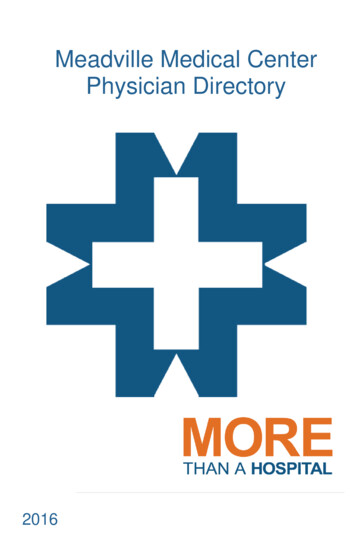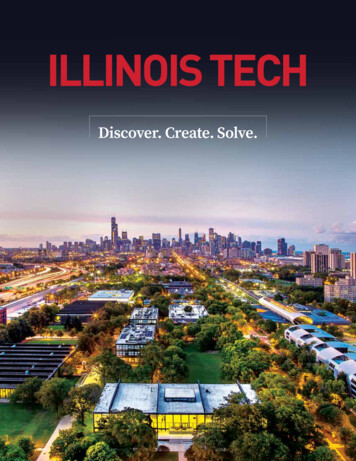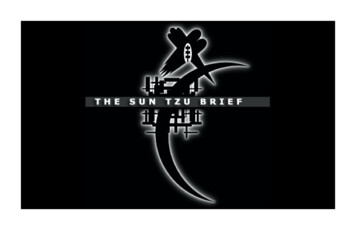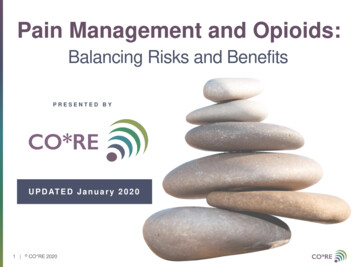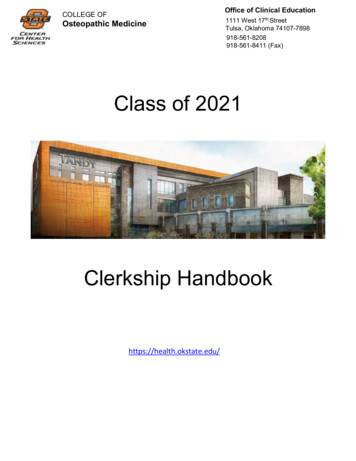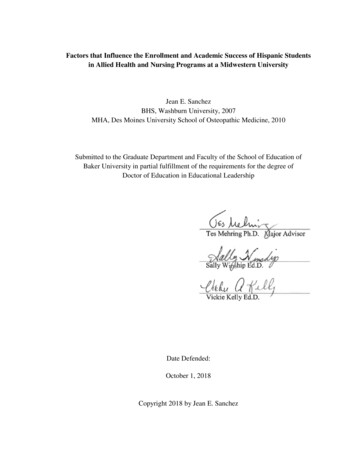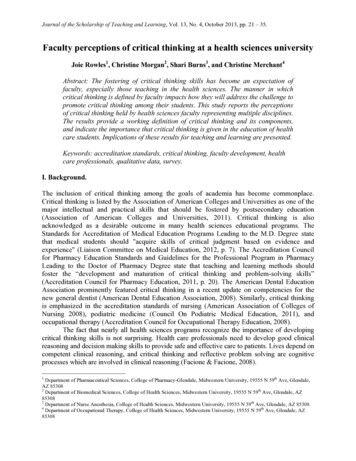
Transcription
A Brief Guide toOsteopathic MedicineFor Students, By StudentsBy Patrick Wu, DO, MPH and Jonathan Siu, DO Second EditionUpdated April 2015
Copyright 2015 No part of this publication may be reproduced or transmitted in any formor by any means electronic or mechanical, including photocopying, recording,or by any information storage and retrieval system, without permission inwriting from the publisher.American Association of Colleges of Osteopathic Medicine5550 Friendship Boulevard, Suite 310Chevy Chase, MD 20815-7231Visit us on FacebookPlease send any comments, questions, or errata to tcymet@aacom.org.Cover Photos: Surgeons astoria/fotolia; Students courtesy of A.T. Still University
Back to Table of ContentsTable of ContentsContentsDedication and Acknowledgements. iiAcknowledgements. iiIntroduction. 1Myth or Fact?. 2CHAPTER 1: What is a DO?. 3CHAPTER 2: The Philosophy and History of Osteopathic Medicine. 9Background. 10Modest Beginnings. 10Higher Standards. 12The Trouble with California. 13Past, Present and Future. 13Famous Names in Osteopathic History and Research . 15CHAPTER 3: Breaking Down Osteopathic Manipulative Medicine. 16Direct Treatment Modalities. 16Indirect Treatment Modalities. 17Both Direct and/or Indirect Treatment Modalities. 17Treatment Modalities that are Neither Direct nor Indirect. 17Frequently Asked Questions (FAQs). 18How is OMM taught in osteopathic medical schools?. 18What evidence is there that OMM actually works?. 18Why do so few practitioners practice OMM on a daily basis? . 20Will public perception of OMM improve in the future?. 20Is OMM the same as chiropractic? . 21Additional Resources. 21References. 22CHAPTER 4: Why Apply to Osteopathic Medical School?. 23U.S. News & World Report Rankings. 23Research and Other Opportunities. 24Growth of the Profession. 25Current Osteopathic Medical Schools in the United States. 26Residency Opportunities. 27Licensing Examinations. 28Conclusion. 29References. 30Recommended Resources. 31Endorsements. 32A Brief Guide to Osteopathic Medicine - For Students, By Studentsi
Back to Table of ContentsDedicationThis guidebook is dedicated to Dr. Patricia Rehfield for all her insight and supportthroughout the many months leading up to its publication.AcknowledgementsTo my sister Sophia and my friend Aysun for first introducing me to the world ofosteopathic medicine. To my brother Nelson and my parents. And, to all my currentand former classmates and professors, without whom my passion for osteopathicmedicine would not be nearly so deep.- Patrick Wu, DO, MPHSpecial thanks to Yuri, who has provided me endless support. I would not be whereI am today without my Uncle Leo and Dr. Yue, who introduced me to osteopathicmedicine, my sister Natalie and my parents, who placed their trust in me, and myfriends and teachers in medical school, who have each inspired me in their own way.- Jonathan Siu, DOiiAmerican Association of Colleges of Osteopathic Medicine
Back to Table of ContentsIntroductionThe decision to enter medical school is undoubtedly one of the most important decisions in a physician’s life. Yet, the majority of Americans are notaware that two different medical schools of thought existin the United States today: allopathic medicine and osteopathic medicine. While allopathic medical doctors, MDs,are almost universally recognized as being fully licensedphysicians, most Americans would have difficulty definingan osteopathic physician (DO). In fact, many patients visitDOs every day without realizing they are receiving medicalcare from an osteopathic physician.This short text was prepared as a guide to osteopathicmedicine for the aspiring physician. When we began considering application to medical schools, neither of us hadheard of the DO degree or osteopathic medicine. And evenwhen we had been exposed to osteopathic medicine, wedidn’t have the time to properly educate ourselves; wewere too busy studying for the MCAT, gathering letters ofreference and writing personal statements – not to mention attending classes, volunteering, shadowing, workingpart-time and holding several leadership positions. Wewere basically doing anything and everything we could tomake ourselves strong candidates for medical schools. Inwriting this guidebook, our goal is to give the prospectiveor current medical school student (and anyone else whomight be interested) a convenient package with which tounderstand osteopathic medicine.You may be thinking to yourself, “What can twosecond-year medical students tell me that I don’t alreadyknow?” While we realize that we still have infinitely moreto learn about the osteopathic approach to medicine (andmedicine in general), we do currently attend an osteopathic medical school. Perhaps more important, we werein your position not too long ago, and we remember veryclearly what it was like to be a “pre-med” student. We hopethat because of this, we can better relate to some of yourconcerns than would, for instance, someone with moretraining and experience. We wish to convey to you the“osteopathic difference,” that is, the difference it makesto attend an osteopathic medical school versus an allopathic medical school. Even after only one year of study,we could not imagine not being able to touch or interactwith patients in the osteopathic manner throughout ourtraining and future clinical practice. Osteopathic manipulative medicine and the art of palpation have truly becomeintegral and meaningful parts of our medical training.In writing this guidebook, our goal is not to imposeour personal opinions about osteopathic medicine on you,but rather to present an overview of the profession thathas been reviewed by our colleagues and professors andincludes pertinent findings obtained through a systematicliterature review of reputable sources.The guidebook is divided into four chapters. The firstchapter is an overview of what osteopathic medicine is andwhat a DO does. Chapter 2 delves into the philosophy andhistory of osteopathic medicine, from its modest U.S. origins to its widespread reach all around the world today.Chapter 3 consists of an outline of the different techniquesinvolved in osteopathic manipulative medicine (OMM)and an FAQ section concerning OMM. Finally, in Chapter4, we discuss the growing opportunities available forosteopathic medical students and DOs.By the time you finish reading this guide, you shouldhave a basic understanding of what osteopathic medicineis, and perhaps a desire to pursue it in the future. Our hopeis that this knowledge will be carried on to your friends,family, classmates, co-workers and colleagues, therebyraising awareness of the osteopathic medical profession inyour respective communities.Patrick Wu, DO, MPHInternal Medicine ResidentLoma Linda UniversityJonathan Siu, DOFamily Medicine ResidentKaiser Permanente Fontana Medical CenterWritten April 2012. Updated May 2014.A Brief Guide to Osteopathic Medicine - For Students, By Students1
Back to Table of ContentsMyth or Fact?In this section, we discuss some of the most common misconceptions aboutosteopathic medicine that exist among the general public and even amongsome members of the medical profession.1. MYTH: DOs are not “real doctors.”their MD school of choice, many applicants chooseto apply only to osteopathic schools based on priorcontact with the profession or an interest in primarycare. Still others choose to attend a DO school evenafter gaining admission to MD schools because of the“osteopathic difference.”FACT: U.S.-trained DOs can prescribe medications,perform surgery, and pursue medical specialties inthe same manner that MDs do.2. MYTH: DOs have limited practice rights.FACT: In the United States, DOs and MDs are held6. MYTH: “Osteopaths” are the same thingas “osteopathic physicians.”equally in the eyes of the law and thus have full practice rights in all 50 states and the District of Columbia.However, only U.S.-trained DOs are considered fullphysicians (along with MDs) in the United States.FACT: Both American osteopathic physicians andnon-U.S. osteopaths call themselves DOs. Americanpractitioners are Doctors of Osteopathic Medicine,and European practitioners have a Diploma of Osteopathy. There is, thus, some confusion regarding thedifference between U.S osteopathic physicians andosteopaths trained in other countries. Osteopaths (theterm used for foreign-trained practitioners who practice osteopathic manipulation) are not physicians.Their training focuses on the musculoskeletal systemand they are not licensed to prescribe medicationsor perform surgeries. They are trained primarily inthe practice of osteopathic manipulative techniques.Conversely, U.S.-trained osteopathic physicians arefully licensed to practice the entire scope of modernmedicine. Although you may hear U.S.-trained osteopathic physicians being referred to as osteopaths,most prefer the term “osteopathic physician” practicing osteopathic medicine in order to distinguishthemselves from foreign-trained osteopaths practicing osteopathy.1This confusion has resulted in some reluctance incountries abroad to accept DOs as fully licensed physicians. Nevertheless, U.S.-trained DOs currently holdfull medical practice rights in over 65 countries, andrestricted rights in a few others. 23. MYTH: Osteopathic medicine is adrugless form of medicine.FACT: Osteopathic medicine’s founder, Andrew TaylorStill, originally intended for his form of medicine to utilize only a select few medications in certain situations atits conception in the 1800s. However, osteopathic medicine is science-based and has greatly evolved since then.During its evolution, osteopathic medicine has incorporated varied modalities of care, including (but notlimited to) pharmaceutical drugs. Since 1929, pharmacology and the use of prescription medication have beentaught in all osteopathic medical schools.4. MYTH: DOs are similar to chiropractors.FACT: While osteopathic manipulative medicinebears some similarity to chiropractic, the two fields ofhealth care represent completely different and separateschools of thought and practice, and have since eachwas conceived in the late 1800s. A detailed breakdownof the differences between osteopathic physicians andchiropractors is provided in Chapter 3.5. MYTH: DOs are just doctors whocouldn’t get into MD schools.FACT: While some osteopathic medical studentschoose a DO school after being denied admission to21 Schierhorn C. AOA House reasserts preferred terms osteopathicphysician, osteopathic medicine. The DO. Aug 4, 2010. Availablefrom: American Osteopathic Association, Chicago, IL. AccessedAug 6, 2011.2 International Practice Rights Map. In American OsteopathicAssociation. Retrieved May 7, 2014 from onal-practice-rights-map.aspxAmerican Association of Colleges of Osteopathic Medicine
Back to Table of ContentsChapter 1What is a DO?“Something Extra, Not Something Else”Fast Facts: There are currently over 73,000 osteopathicphysicians in practice in the United States.1 More than 20 percent of new medical studentsin the United States are training to be osteopathic physicians.2 During the 2014-2015 academic year, therewere more than 24,500 osteopathic medicalstudents in training.2 More than 6,700 new medical students begantheir training as osteopathic physicians in fall2014.3 There were more than 18,000 applicants toosteopathic medical colleges for the 2014-2015entering medical school class.2 Osteopathic physicians comprise roughly 7percent of the practicing physician populationin the United States, but account for 16 percentof the total number of patient visits in communities with small populations (fewer than2,500).2There are two types of fully licensed medical doctors in the United States: MDs and DOs. While theMD degree stands for “Doctor of Medicine,” the DOdegree stands for “Doctor of Osteopathic Medicine.” DOspractice osteopathic medicine, which represents a schoolof medical thought first introduced by Dr. Andrew TaylorStill in 1874. Osteopathic medicine encompasses a unifying philosophy and approach to patient care, as well asa system of diagnosis and treatment through the use ofhands-on, manual manipulative medicine.There exists a great deal of similarity between osteopathic medicine and what is known as “allopathic” (MD)medicine. Osteopathic physicians work alongside theirMD counterparts in the same hospitals, private practices,and academic institutions. Like MDs, DOs are licensed topractice medicine, perform surgery, and prescribe medications in all 50 states. They may enter any specialty ofmedicine that they desire; such specialties range fromprimary care, such as pediatrics, internal medicine andfamily practice, to more specialized fields such as surgery,radiology, and anesthesiology. Both MDs and DOs canserve in all branches of the military service, and the twoprofessions they represent are seen equally in the eyes ofthe law.2So what makes osteopathic medicine different? Firstof all, osteopathic medicine, as an establishment and aprofession, is very much separate from the allopathic medical profession. Accreditation organizations differ betweenthe two professions. The American Osteopathic Association (AOA) serves as the primary certifying body andaccreditation agency for health care facilities and graduatemedical education (GME), and the AOA Commission onOsteopathic College Accreditation (COCA) accredits theosteopathic medical colleges. The Accreditation Councilfor Graduate Medical Education (ACGME, which alsoaccredits dual residency programs) and the Liaison Committee on Medical Education (LCME) serve allopathicmedicine in a similar fashion. In addition, just as thereare specifically osteopathic colleges, there are osteopathicboard examinations, residency programs, hospitals, professional associations, and scientific journals. Dependingon the state, boards granting medical licensure may bemixed (DO and MD) or separate, with distinct osteopathicboards handling only DO licensure.7 Due to the disproportionate geographic distribution of DOs in the UnitedStates, which tends to be most concentrated the Midwestand Northeast, the presence of osteopathic medicine isgreater in some states than others. States with larger DOpopulations are more likely to have separate osteopathiclicensing boards than those with smaller DO populations.But what really distinguishes osteopathic medicine isthe unifying approach and philosophy by which its physicians are guided in their practice of medicine. DOs pridethemselves on their emphasis on preventive medicine, apatient-centered, holistic approach to care, and patientempowerment to strive toward the body’s natural, optimalstate of structure/function, and self-healing and health.They also utilize diagnosis of and manual manipulationof the neuromusculoskeletal system and stress its interconnectedness with every other organ system in the body.The belief in the “osteopathic difference” is quite widespread among osteopathic physicians. In fact, a randomnational mail survey of 950 osteopathic physicians foundthat a majority (59 percent) of respondents believed thattheir manner of practice as a DO was different from thatof MDs. Furthermore, 72 percent of these 560 respondentsA Brief Guide to Osteopathic Medicine - For Students, By Students3
Back to Table of ContentsChapter 1: What is a DO?cited distinctions in their approach to medical care, suchas the use of osteopathic manipulative medicine (OMM), acaring doctor-patient relationship, and a hands-on style oftreatment and diagnosis, as main distinguishing factors.8The 2003 Maine Osteopathic Outcomes Study(MOOS) set out to answer the question, “Do osteopathicphysicians differ in patient interaction from allopathicphysicians?” Researchers took audio-recordings of patientvisits with both MDs and DOs and used a 26-item indexof physician-patient communications considered to bereflective of modern osteopathic principles to judge thehypothesized difference in patient interaction. The studyfound that the DOs demonstrated a more personal, “osteopathic” communication style based on the 26-item indexthan did the MDs. The DOs were significantly more likelyto use the patient’s first name, discuss preventive measures, and discuss the patient’s emotional state, family life,and social activities. Despite the study being small (18 participant physicians and 54 patient visits total), it was conducted in a double-blind fashion and offers importantinsights into the distinction between DOs and MDs.9Increasingly, however, the lines between DO and MDare becoming blurred. In medicine today, “the training,practice, credentialing, licensure, and reimbursement ofosteopathic physicians are virtually indistinguishable fromthose of allopathic physicians, with four years of osteopathic medical school followed by specialty and subspecialty training and [board] certification.”10 Bob Jones,author of The Difference a D.O. Makes, once proclaimed,“Osteopathic medicine is something extra, not somethingelse.”11 He was referring to the additional 200 – 300 hours ofosteopathic-specific instruction that osteopathic medicalstudents receive in conjunction with coursework equivalent to that of their allopathic counterparts.2The osteopathic curriculum consists of all the traditional disciplines: anatomy, behavioral science, biochemistry, biostatistics, embryology, genetics, histology,immunology, microbiology, pathology, pathophysiology,pharmacology and physiology (see Figure 1-1). Osteopathic medical students often study the same textbooksused in allopathic schools, and are taught by DOs as wellas MDs.12 However, unlike their allopathic counterparts,osteopathic students also spend at least 200 hours of preclinical education learning about the history of osteopathic medicine, the core osteopathic principles and philosophies, and OMM.2 After attending medical school,which is usually composed of two years of in-classroomdidactic courses followed by two years of clinical rotationsin office, clinic, and hospital settings, osteopathic physicians go on to complete three to eight years of residency,the length of which depends on the specialty the doctorelects to pursue (see Table 1-1). While MD students typically rotate through large affiliated hospitals during theirclinical years, osteopathic medical students are oftenexposed to a wider variety of clinical settings (i.e., hospitalsof varying size, community-based clinics, etc.).Figure 1-1. A general guide to the osteopathic medical school curriculum. Please check with individual colleges of osteopathicmedicine for specifics.Year 1Year 2Core Clinical Clerkships(Years 3 and 4)AnatomyGerontologyEmergency MedicineAnesthesiologyPhysiologyCardiologyFamily MedicineCardiologyClinical SkillsGastrointestinal SystemInternal MedicineGastroenterologyRadiologyHematopoietic SystemObstetrics and GynecologyLaboratory MedicineOsteopathic Principlesand PracticesOsteopathic Principles andPracticesOsteopathic Principles andPracticesNephrologyMicrobiology iatry and BehavioralScienceOncology and orySurgeryEthics and JurisprudenceFamily MedicineGenitourinary SystemReproductive SystemPediatrics/Growth andDevelopment4Other Clinical Clerkships(Years 3 and 4)American Association of Colleges of Osteopathic monary MedicineRadiology
Back to Table of ContentsChapter 1: What is a DO?Table 1-1. Steps to Licensure in the United States: DO vs. MDDoctor of Osteopathic Medicine (DO)Doctor of Medicine (MD)Pre-medical RequirementsVaries by school; most often: General Chemistry: 2 semesters/3 quarters (with laboratories) General Biology: 2 semesters/3 quarters (with laboratories) Organic Chemistry: 2 semesters/3 quarters (with laboratories) General Physics: 2 semesters/3 quarters (with laboratories) Often additional Mathematics and/or English and Writing courses may also berequiredStandardized AdmissionsExaminationMedical College Admissions Test (MCAT)Medical College Admissions Test (MCAT)Years of medical school44Step 1COMLEX Level 1 required;USMLE Step 1 optionalUSMLE Step 1 requiredStep 2COMLEX Level 2 required;USMLE Step 2 optionalUSMLE Step 2 requiredStep 3COMLEX Level 3 required for some statestUSMLE Step 3 optionalUSMLE Step 3 requiredResidencyChoice of one of the following:ACGMEAOAParallel/Dually Accredited(by ACGME and AOA)ACGMEBoard CertificationOsteopathic (AOA) or allopathic (ABMS)medical specialty boardsAllopathic (ABMS) medical specialtyboardsMedical Licensing Exams:Some states require the first year of residency (PGY-1) be AOA-approved; Resolution 42.tThese states are: California, Tennessee, Pennsylvania, West Virginia, Michigan, Oklahoma, Florida, and Vermont.Producing competent primary care physicians, in particular, is part of the mission statement of many, if not all,U.S. osteopathic medical schools. According to the 2014U.S. News and World Report, a popular source of medicalschool rankings, osteopathic medical schools rank amongthe top producers of primary care doctors in the nation,with Michigan State University College of OsteopathicMedicine (MSUCOM) being one of the ten top-rankedmedical school in this category.13 Consequently, some curricula may place a greater emphasis on such skills as bedside manner, interviewing and building the physicianpatient relationship. These schools do not in any way forcestudents to go into primary care – many students simplychoose to do so.14Osteopathic medical schools also use differing criteria when selecting candidates to interview and/orextending offers of admission. For example, in the evaluation of applicants, osteopathic medical schools placemore emphasis on candidates’ interest in and knowledgeof osteopathic philosophy. They also are more likely toseek out students who are interested in pursuing careersin primary care and in rural or underserved areas.3 Osteopathic admissions programs often view the candidate as awhole, and are more forgiving in the sense that they acceptgrade replacement for repeated courses. They are less likelyto place as much emphasis on Medical College AdmissionsTest (MCAT) scores and/or GPAs as allopathic schools do.12These differing criteria may explain some ofthe existing disparities in average admissions statistics between admitted students of osteopathic medical schools and those of allopathic medical schools. The19,517 matriculating allopathic students in 2012 had anaverage combined MCAT score of 31.2 (Physical Science:10.5, Verbal Reasoning: 9.8, Biological Science: 10.9) andaverage GPAs of 3.63, 3.75, and 3.68 for science, nonscience, and total, respectively.15 In contrast, the sameyear, the 5,464 matriculating osteopathic medical studentshad an average MCAT score of 26.85 (PS: 8.74, VR: 8.63, BS:9.48) with average science, non-science, and total GPAs of3.37, 3.59, and 3.49, respectively.16The other major factor contributing to this disparityis the difference in the actual applicant pools. Currently,the majority of medical school applicants do not apply toosteopathic medical programs, likely due to a general lackof accessible and reliable information concerning osteopathic medicine. Many applicants have not had any signif-A Brief Guide to Osteopathic Medicine - For Students, By Students5
Back to Table of ContentsChapter 1: What is a DO?icant exposure to the osteopathic profession, lack mentorsfamiliar with the field, or have been misinformed by theirpeers and advisers. From our personal experience, thismisinformation can sometimes perpetuate misconceptions, including the perception that osteopathic schoolsserve primarily as a “Plan B” rather than as an equallyviable alternative to allopathic schools.In fact, in a survey conducted by AACOM in which3,215 respondents of 14,943 students who applied duringthe 2012 AACOMAS application cycle were asked to ranktheir top reasons for matriculating at a particular medicalschool (osteopathic or allopathic), an MD student’s preference of having an MD over a DO degree was ranked belowgeographic location. The chart below presents the possiblereasons for matriculation that were listed in the survey:Only a minority of the overall U.S. population isactually aware of the existence of DOs. In a national,random digit-dialing telephone survey of 499 adult, noninstitutionalized, household respondents conducted in2000, only 46 percent were aware of osteopathic physicians, while 16 percent knew they had actually visited aDO and a mere 7 percent knew they were current patientsof a DO. Awareness was found to be directly associatedwith age, education, race, and Midwest residence (probably due to osteopathic medicine’s Midwest origins).17Thus, young adults, who represent the majority of the medical school application pool, are thought to have a lowerawareness of osteopathic medicine. However, the results ofOSTEOSURV 2010, the most recent update to this decennial national survey, are set to be released later this yearand may reflect the recent upsurge in the osteopathic physician population (see Figure 2-1).While the admissions criteria and statistics may differbetween osteopathic and allopathic medical schools, thestudent demographics in the two professions are fairlysimilar in terms of race/ethnicity, and are virtually identical in terms of sex, as detailed in Figure 1-2, Table 1-2,Figure 1-3, and Table 1-3.18, 19, 20 However, racial minorities are consistently underrepresented in the medical profession, and this issue seems to be more pronounced inthe osteopathic medical student population. The reasonsfor this are complex, but one potential factor may be thatosteopathic medical schools have less funding devotedto scholarships for economically disadvantaged students.Top Reasons for Selecting Medical SchoolCollege's geographicloca on18%53%College's approach tolearning and teaching37%39%College's reputa on36%18%
A Brief Guide to Osteopathic Medicine - For Students, By Students 3 Back to Table of Contents medicine that they desire; such specialties range from primary care, such as pediatrics, internal medicine and family practice, to more specialized fields such as sur
